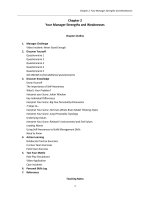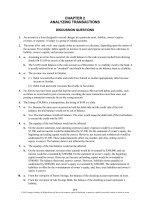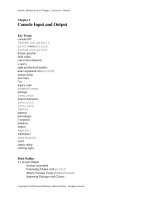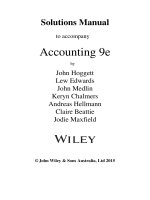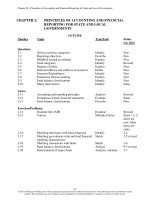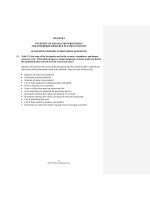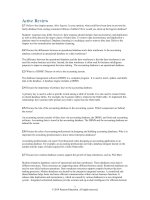Test bank and solution of biology life on earth with physiology 10e (2)
Bạn đang xem bản rút gọn của tài liệu. Xem và tải ngay bản đầy đủ của tài liệu tại đây (106.24 KB, 9 trang )
CHAPTER 2 ATOMS, MOLECULES,
AND LIFE
LECTURE OUTLINE
Case Study: Unstable Atoms Unleashed
2.1
What Are Atoms?
A. Atoms Are the Basic Structural Units of Elements (Figures 2-1 and 2-2, and Table 2-1)
1. An element is a substance that cannot be separated into simpler substances
2. An atom is the smallest unit of an element (Table 2-1)
B. Atoms Are Composed of Still Smaller Particles (Table 2-1 and Figure 2-1)
1. Atoms are composed of subatomic particles: protons, neutrons, and electrons
2. The mass number is equal to the mass of the protons and neutrons
3. Protons and neutrons cluster in the atomic nucleus
4. Negatively charged electrons orbit the atomic nucleus
C. Elements Are Defined by Their Atomic Numbers
1. Atomic number is the number of protons in an atom
D. Isotopes Are Atoms of the Same Element with Different Numbers of Neutrons
1. Some isotopes are radioactive
➢ Science in Action: Radioactive Medicine (Figures E2-1 and E2-2)
2. Some radioactive isotopes damage cells
E. Nuclei and Electrons Play Complementary Roles in Atoms
1. Electrons occupy complex regions around the nucleus
a. These regions are called electron shells and correspond to different energy levels (Figure 2-2)
b. Electron shells allow interactions, or bonds, with other atoms
2. Electrons can capture and release energy (Figure 2-3)
3. As atomic number increases, electrons fill shells increasingly distant from the nucleus
➢ Case Study Continued: Unstable Atoms Unleashed
2.2
How Do Atoms Interact to Form Molecules?
A. Atoms Form Molecules to Fill Vacancies in Their Outer Electron Shells
1. A molecule consists of two or more atoms of the same or different elements held together by
interactions between their outer-shell electrons
2. Atoms with full outer electron shells do not react with other atoms and are inert
3. Atoms that do not have full outer shells are considered reactive
B. Chemical Bonds Hold Atoms Together in Molecules (Table 2-3)
1. Chemical bonding involves the gain, loss, or sharing of electrons
a. Ionic bonds
b. Covalent bonds
c. Hydrogen bonds
C. Ionic Bonds Form Among Ions (Figure 2-4)
1. The outermost electron shell is almost empty or almost full
2. Ions are atoms that become stable by gaining or losing electrons
3. Ionic bonds are electrical attractions between positive and negative ions
D. Covalent Bonds Form by Sharing Electrons (Figure 2-5 and Table 2-4)
1. If the outermost electron shell is partially full, an atom may form a covalent bond
2. Covalent bonds form when atoms become stable by sharing electrons
3. Most biological molecules utilize covalent bonding
10
Copyright © 2012 Pearson Education, Inc.
Chapter 2 Atoms, Molecules, and Life
E. Covalent Bonds May Produce Nonpolar or Polar Molecules (Figure 2-6)
1. Nonpolar covalent bonds involve the equal sharing of electrons
2. Polar covalent bonds involve the unequal sharing of electrons (H2O)
3. Free radicals are unstable molecules with an unfilled outermost electron shell
a. They can tear other molecules apart
➢ Health Watch: Watch Out for Free Radicals (Figures E2-3 and E2-4)
F. Hydrogen Bonds Are Attractive Forces Between Certain Polar Molecules
1. Hydrogen bonds are bonds between parts of polar molecules (Figure 2-6)
2. Hydrogen bonds are responsible for the unique properties of water
➢ Lecture Activity 2.1: Exercise in Chemical Bonding
➢ Lecture Activity 2.2: Atomic Love Connection
➢ Lecture Activity 2.3: Atoms, Molecules, and Compounds
2.3
Why Is Water So Important to Life?
A. Water Molecules Attract One Another (Figure 2-7)
1. Cohesion occurs when water molecules stick together
2. Surface tension results when the surface of water is resistant to being broken
➢ Have You Ever Wondered…Why It Hurts So Much to Do a Belly Flop?
B. Water Interacts with Many Other Molecules (Figures 2-8 and 2-9)
1. Water, a type of solvent, is capable of dissolving a wide range of substances
2. Hydrophilic molecules exhibit attraction to water (as well as ions and polar molecules)
3. Hydrophobic molecules exhibit no attraction to water (do not dissolve)
C. Water Moderates the Effects of Temperature Changes (Figure 2-10)
1. It Takes a Lot of Energy to Heat Water
a. Specific heat is the amount of energy required to heat 1 gram by 1°C
b. Water has a high specific heat
c. It takes more energy to heat water than most substances
2. It Takes a Lot of Energy to Evaporate Water
a. Heat of vaporization is the amount of heat required to vaporize a substance
b. Water has a high heat of vaporization
➢ Case Study Continued: Unstable Atoms Unleashed
➢ Lecture Activity 2.4: Specific Heat of Water and Body Temperature
D. Water Forms an Unusual Solid: Ice (Figures 2-11 and 2-12)
1. Most liquids become more dense when they are solid
2. A unique property of ice is that it is less dense than liquid water
E. Water-Based Solutions Can Be Acidic, Basic, or Neutral (Figures 2-13 and 2-14)
1. Pure water contains equal amounts of hydrogen and hydroxide ions
+
–
2. Acidic solutions contain more hydrogen ions (H ) than hydroxide ions (OH )
–
+
3. Basic solutions contain more hydroxide ions (OH ) than hydrogen ions (H )
4. The pH scale expresses the degree of acidity of a solution and ranges from 1–14
a. Acids have a pH below 7 (more H+ than OH–)
b. Bases have a pH above 7 (more OH– than H+)
c. Water has a pH of 7 (equal amounts of H+ and OH–)
5. A buffer helps maintain a solution at a relatively constant pH
Case Study Revisited: Unstable Atoms Unleashed
KEY TERMS
acid
acidic
antioxidant
atom
atomic nucleus
atomic number
electron shell
element
free radical
heat of vaporization
hydrogen bond
hydrophilic
Copyright © 2012 Pearson Education, Inc.
nonpolar covalent bond
pH scale
polar covalent bond
proton
radioactive
solution
11
12
Instructor Guide Biology: Life on Earth
base
basic
buffer
chemical bond
cohesion
covalent bond
dissolve
electron
hydrophobic
hydrophobic interaction
ion
ionic bond
isotope
mass number
molecule
neutron
solvent
specific heat
surface tension
LECTURE ACTIVITIES
Lecture Activity 2.1: Exercise in Chemical Bonding
Estimated Time to Complete: 10–25 minutes
Section Reference
2.2 How Do Atoms Interact to Form Molecules?
Introduction
This activity is a basic introduction to the concept of chemical bonding. This is a short, in-class exercise that can
follow an introductory discussion of atomic structure and bonding. Students will take the number of their birth
month as their atomic number. Given this information, they will be able to determine the configuration of
electrons. They will then be able to determine how this atom will interact with other atoms, if at all. Students
will form groups with other students to form ions or molecules and will present their bond formation to the
class.
Chapter Concepts Addressed
1. Students learn about atomic structure and electron configurations
2. Students apply their knowledge of electron configuration to atomic bonding
3. Students interact with classmates to form ionic or covalent bonds
Materials Needed
No specific materials are needed.
Procedures
1. Instruct the students to identify their birth month on a piece of paper. They will consider the number of
their birth month to be their atomic number.
2. Next, instruct them to draw their appearance as an atom. Specifically, they must determine their electron
configuration and how many electrons are in their outermost shell.
3. Using this information, they should determine what type of bond they might like to form to become
stable and fill the outermost shell.
4. Students must then form a bond with another classmate so that both “atoms” become stable.
5. These student groups of bonded atoms can then present their bond to the class and explain why they are
both now stable. Alternatively, to save class time, they could write this information on a sheet of paper to
be handed in.
Assessment Suggestions
Evaluate the student bonds that are formed and assign a grade for class participation.
Copyright © 2012 Pearson Education, Inc.
Chapter 2 Atoms, Molecules, and Life
13
Lecture Activity 2.2: Atomic Love Connection
Estimated Time to Complete: 25–30 minutes
Section Reference
2.2 How Do Atoms Interact to Form Molecules?
Introduction
This activity reinforces students’ understanding of atomic structure, as well as ionic and covalent bonds. These
topics should be covered in class prior to beginning this activity. In this activity, the students will either choose
or be assigned a particular element and will write a “personal ad” for that atom. This ad should describe the
properties of the atom and also describe what type of bond the atom would “like” to form. Following
completion of the handout, students should share their ads with each other to find a good bonding match
between atoms.
Chapter Concepts Addressed
1. Students learn about the structure of atoms
2. Students apply their understanding of atomic structure to determine whether an atom is inert or reactive
3. Students learn how to determine whether an atom will form covalent or ionic bonds
Materials Needed
• Handout included in this activity
• Periodic table for the entire class or for each student
Procedures
1. Hand out worksheet with background information.
2. Students should work individually to write their own personal ad for their atom. The instructor may
choose to assign an element, or students may choose from the elements listed on the worksheet. In larger
classes, more than one student can be assigned the same element.
3. The students should first determine the atomic number of their element and how many electrons are in
the outer shell. This information can then be used to determine if the atom is most likely to form a
covalent or ionic bond.
4. Students can then interact with each other in groups to find matches to their ads. For example, a carbon ad
would match up well with a hydrogen ad to form covalent bonds.
Assessment Suggestions
You may collect the students’ sheets for grading or assign an in-class participation grade if students read their
ads to the class.
Copyright © 2012 Pearson Education, Inc.
Name: ________________________
Date: _________________________
Instructor: _____________________
Course Section: _________________
Lecture Activity 2.2 Handout—Atomic Love Connection
Choose one of the following elements:
carbon
nitrogen
oxygen
sulfur
magnesium
chlorine
sodium
potassium
hydrogen
calcium
phosphorus
bromine
1.
Determine the atomic symbol: ___________
2.
Use the periodic table to determine the atomic number: ___________
3.
Describe how you will determine if the atoms of your element are inert or reactive.
4.
Use the characteristics of your atom to write a “personal ad” for it. Be creative! Your ad should include
information regarding how your element might form bonds with other elements.
See the example below as a guide.
Example: Fluorine (F); atomic number = 9
Personal ad: Single fluorine atom seeking another kind atom willing to donate one electron to add
stability to my life. I currently have seven electrons in my outer shell and am willing to form an ionic
bond with any atom who answers this ad.
5.
When you are done, see if you can find another personal ad that is a good match for yours (your atomic
love connection). Write your match below. What kind of bond will you form?
Copyright © 2012 Pearson Education, Inc.
Chapter 2 Atoms, Molecules, and Life
15
Lecture Activity 2.3: Atoms, Molecules, and Compounds
Estimated Time to Complete: 15–25 minutes
Section References
2.1 What Are Atoms?
2.2 How Do Atoms Interact to Form Molecules?
Introduction
This activity is designed to help students understand the differences among atoms, molecules, and compounds.
The activity should be done prior to the topics being covered in class to help the students construct their own
understanding of atoms, molecules, and compounds. This is a compare-and-contrast activity that will help
reinforce the students’ understanding of atomic structure, molecules, and compounds.
Chapter Concepts Addressed
1. Students apply their knowledge of atoms
2. Students gain an understanding of the role of atoms in forming molecules and compounds
Materials Needed
• Worksheet
• Access to computers for Internet searching
Procedures
1. Assemble the students into pairs.
2. Hand out the worksheet with questions that the students will be answering.
3. Have the students perform an Internet search using the following search terms: atoms, molecules, compounds.
4. Allow the students to answer the questions on the worksheet while they are searching the Internet.
5. You may discuss the answers in class or collect the sheets to grade them.
Assessment Suggestions
You may collect the students’ question sheets to grade. Alternatively, you may ask similar questions on a quiz
or exam.
Copyright © 2012 Pearson Education, Inc.
Name: ________________________
Date: _________________________
Instructor: _____________________
Course Section: _________________
Lecture Activity 2.3 Handout—Atoms, Molecules, and Compounds
1.
Describe two differences between molecules and compounds.
2.
Describe two similarities between molecules and compounds.
3.
Why are O2 and H2 not considered compounds?
4.
The element helium (He) is said to be inert. What does this mean? What types of molecules is this
element likely to form? (HINT: You may want to do a separate Internet search for this question.)
Copyright © 2012 Pearson Education, Inc.
Chapter 2 Atoms, Molecules, and Life
17
Answer Key
Questions 1 and 2 will have multiple answers. Reference the textbook or the Web sites found in the search for
possible answers.
3.
They contain only one type of element. Compounds contain more than one different type of element.
4.
Inert means that the element has a full outer shell of electrons. This element will not form any molecules.
Because its outer shell of electrons is full, it is unlikely to bond with other atoms.
Lecture Activity 2.4: Specific Heat of Water and Body Temperature
Estimated Time to Complete: 20–25 minutes
Section Reference
2.3 Why Is Water So Important to Life?
Introduction
This activity helps students apply their understanding of the specific heat of water to a biological concept. The
ability to maintain body temperature is an important feature of the human body that is, in part, attributable to
this important property of water.
Chapter Concepts Addressed
1. Students define the term specific heat
2. Students apply the specific heat of water to the human body’s ability to maintain body temperature
3. Students examine how liquids of different specific heat could affect body temperature regulation
Materials Needed
• Handout included with this activity
• Pens/pencils
Procedures
1. This activity should be completed following a class discussion of the meaning of the term specific heat.
2. Give a copy of the handout to each student. Allow them to form groups of two or three students to work
together to complete the worksheet. Alternatively, this could be a homework assignment.
3. You may either collect the sheets for grading or discuss the answers in class.
4. Important points to address are:
A. The specific heat of a substance is defined as the amount of heat that must be absorbed or lost for 1 g of
that substance to change its temperature by 1°C.
B. Because the body is composed mainly of water with a high specific heat, the human body is able to
resist changes in body temperature. Therefore, it takes a long time for the human body to overheat. It
will take less time for all of the “space” organisms to overheat because their specific heats are lower.
Assessment Suggestions
You may collect the students’ handouts to grade. Alternatively, you may assess the students’ involvement in the
class discussion that follows completion of the worksheet.
Copyright © 2012 Pearson Education, Inc.
Name: ________________________
Date: _________________________
Instructor: _____________________
Course Section: _________________
Lecture Activity 2.4 Handout—Specific Heat and Regulating
Body Temperature
Background Information
Our bodies are 80% water. Imagine that you work for NASA and have recently discovered many new life-forms
on distant planets. Space probes have gathered some preliminary data about these living creatures. Specifically,
you have learned that each life-form is composed primarily of another liquid rather than water. Work in small
groups to answer the following questions.
Preliminary data
Organism A: body composition is 77% ethyl alcohol (specific heat = 0.60 cal/g °C)
Organism B: body composition is 81% kerosene (specific heat = 0.47 cal/g °C)
Organism C: body composition is 83% seawater (specific heat = 0.94 cal/g °C)
Organism D: body composition is 81% sulfuric acid (specific heat = 0.35 cal/g °C)
Human body: body composition is 80% water (specific heat = 1.00 cal/g °C)
Questions
1.
Define the term specific heat.
2.
It takes ___________ cal of heat to raise the temperature of 1 g of ethyl alcohol by 1°C.
3.
You place one beaker of water on one hot plate and a beaker of sulfuric acid next to it on the same hot
plate. Which one will heat up faster? Explain why.
4.
If you were to place each organism in direct sunlight on a warm day, which organism’s body temperature
will increase more rapidly than the human body? Which organism’s body temperature will increase less
rapidly than the human body? Explain why. (Use the term specific heat in your answer.)
5.
Put the four organisms in order starting with the one whose body temperature will increase the fastest and
proceeding to the one whose body temperature will increase the slowest.
Copyright © 2012 Pearson Education, Inc.
